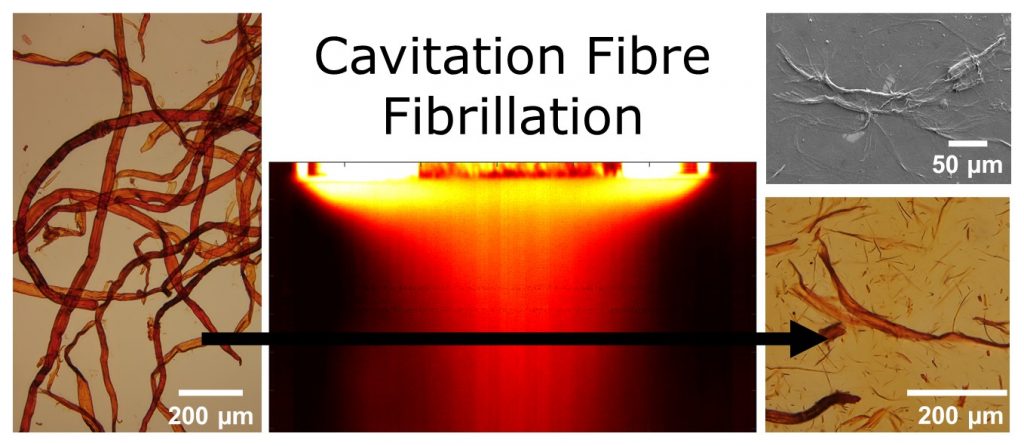Cavitation Fibrillation of Cellulose Fibres (CaFiCeFi)

The project is of explorative nature and aims on mapping the destructive nature of cavitation on cellulose fibres. Neither cavitation nor the dispersion of cellulose fibres in its constituents (cellulose fibrils for dissolving pulp fibres) is fully understood. The project objective is to guide whether cavitation is a mean for efficient and dedicated fibrillation at […]
Flow assisted assembly of biocomposite filaments based on Cellulose Nanofibrills (CNF)
The fundamental facet of this project is to design and fabricate functional composite filaments based on CNF and polymers. The aim is to prepare filaments with superior mechanical properties and/or advanced functions. In this project, we are going to control the interaction between individual CNFs during flow assisted assembly using different heterofunctional polymers. The project is […]
Enzyme discovery and enzyme application on wood
Our project aims to identify enzymes that have the ability to increase the efficiency of the biorefinery process, designed for the production of biofuels, -chemicals, and -materials. Specifically, this project aims to find, characterize, and utilize, enzyme that attack specific bonds in the complex biomass structure, to increase the saccharification efficiency of cellulolytic enzyme cocktails […]
KAW Biocomposites
Technical objective The project is focused on materials design of biocomposites which are semi-structural, recyclable and/or biodegradable. The term “semi-structural” needs to be defined. If 30wt% glass fiber/polypropylene is selected as the reference material for substitution, it would mean that the modulus should be > 6 GPa and the tensile strength > 85 MPa. In […]
Conducting cellulose fibres and yarns for circular electronic textiles
Conducting fibres and yarns are essential components of the next generation of wearable electronics that seamlessly integrate electronic function into one of the most versatile and most widely used form of materials: textiles. Necessary requirements are a high degree of wash and wear resistance. Traditionally, colouring of cotton, viscose and lyocell fibres is done with […]
Biocomposites from fibres and nanocellulose
The project is a post-doc project within WWSC 2.0 The engineering aim brought forward in the project is to produce composities by using chemically modified fibres and nanocellulose and use these as reinforcing-structural elements in a polymer matrix. The resulting composites material must be manufactured with conventional, possible slightly modified, polymer processing techniques in order […]
Hybrid composites based on nanocellulose and 2D-materials
Nanocellulose in the form of fibrils (CNF) from wood is a new building-block for complex nanocomposites. Both the new materials and CNF itself are of major scientific and technical interest, with strong industrial potential. The use of colloidal systems makes it possible to mix CNF with for instance montmorillonite clay (MTM) or graphene oxide (GO) […]
Composite of lignin derivatives and conducting polymers for electro-capturing of toxic heavy metals
Among the 100% water on planet earth, less than 1% is liquid fresh water and about 0.0025% is available fresh water for drinking, food and industries. More than 90% of the fresh water is utilized for agriculture and industries. Pollution of water is thus an increasingly important problem. One of the most challenging depollution process […]
Porous, optical and IR-absorbing cellulose for solar evaporators
This project aims at investigating how conducting polymers interact with forest-based materials to form hierarchically nanostructured aerogels. We will develop protocols for fine tuning the structural and mechanical properties of cellulose-base conducting aerogels, and to control the penetration of solar absorbers (i.e. conducting polymers) in the nanostructured forest-based aerogels. We will study how energy is […]
Soft cellulose-based robotics
The project is focused on the development of novel concepts for soft electromechanical actuators and robotics based on nanocellulose composites. Nanocellulose foams are light weight and compressible, making them ideal for functionalization for actuators. Magnetic and electronic functional composites will be developed and fabricated into novel device concepts. The project is part of WWSC.
Polysaccharide films – formation and properties
Turning wood-based polymers and particles into films is vital for majority of their utilization (packaging, support materials) and for fundamental analytics (model surfaces for adsorption, interaction studies, strength characterization). Cellulose, hemicelluloses and lignins have distinct (from one another) intrinsic film formation behavior and properties that span from solubility, molecular weight and flexibility, and polarity. Main […]
Novel Lignin Based Thermoset Resins
The project focuses on synthetic pathways to modify lignin to introduce chemical groups suitable for cross-linking reactions and elaboration on the mechanical properties of the formed materials. The main focus is allylation, introducing an allyl ether functionallity selectively on phenols, and thiol-ene reactions for cross-linking of the thermoset resin. This is performed on technical lignin […]

